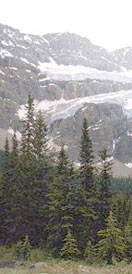|
NRCan Home > About Us > Trailblazers > Sir William Edmond Logan

Trailblazer
Sir William Edmond Logan
1798-1875
 At nearly 6,000 metres above sea level, Mount Logan, the highest peak in Canada, stands as a monument to the achievements of the great Canadian geologist, Sir William Edmond Logan. Sir William, who mapped parts of Canada and discovered many of its natural resources, was the driving force behind the Geological Survey of Canada (GSC) for more than a quarter of a century. At nearly 6,000 metres above sea level, Mount Logan, the highest peak in Canada, stands as a monument to the achievements of the great Canadian geologist, Sir William Edmond Logan. Sir William, who mapped parts of Canada and discovered many of its natural resources, was the driving force behind the Geological Survey of Canada (GSC) for more than a quarter of a century.
Born in Montréal in 1798, Sir William was the third child of Scottish entrepreneurs, who made their fortune in a successful bakery and real estate. His parents wanted their children to have the best education available. They sent him and his siblings to a prestigious school in Montréal, then to high school in Scotland. Although he enrolled in Edinburgh University after graduation, the young Canadian was not content with academic life and soon joined his uncle, Hart Logan, first in his accounting office, and then in the family's thriving copper-smelting business in Wales.
The Self-Education of a Rock Lover
Working in the copper-smelting trade fostered Logan's growing interest in geology, including coal mining, which was of increasing financial significance at the time. Unwilling to accept an unearned position, he invested all of his energy in his uncle's business and was led into the intricate world of geological mapping. His hands-on approach took him away from the desk and into the mines, as he scoured the area in pursuit of coal.
Although Logan had no formal training in geology, the surveying he did for his uncle's company received acclaim in Britain. The director of the Geological Survey of Great Britain was familiar with Logan's work, and in 1837 Logan was elected to the Geological Society of London.
More than a Hobby
In the early 1840s, Logan learned that the Canadian government was considering funding its own geological survey. He was excited by the project and solicited the Governor General, Sir Charles Bagot, for the position of first director. He was hired after the director of the British Geological Survey and several other respected British geologists recommended him. Logan became the first director of the newly formed GSC in 1842.
Logan and two assistants began work in the Gaspé region in 1843. The goal of the survey was to locate coal deposits, but after extensive investigating, Logan determined that there was no coal in the area. However, his artistic abilities and precise note keeping proved valuable when it came time to demonstrate that his efforts had not been fruitless. He and his small crew had classified rocks, discovered countless minerals and accurately mapped the region - all feats never before undertaken.
Ambassador for the Geological Survey of Canada
In the following few years, Logan began the first studies of Precambrian rock in the Canadian Shield and explored the Timiskaming, Ottawa and Lake Superior regions.
He was intent on promoting the GSC and took it upon himself to act as an ambassador for the Survey. Over the next 20 years, he split his time between working in the field and attending international functions. His work achieved international renown at the Paris Exhibition in 1856, and shortly after he was knighted by Queen Victoria.
By the time Sir William retired at age 77, he had won numerous awards and, most importantly, established the GSC as an international geological authority. He and his small team were also instrumental in the expansion and mapping of Canada.
A Life's Work
 Logan's fierce commitment to the geological exploration of Canada also fostered the growth of several other Canadian institutions. The GSC library, which still exists today, was initially stocked with books purchased by Logan himself. His own collection of rock specimens from the field was exhibited in the first geological museum in Canada. The museum was commissioned in 1856 and initially housed in the building Logan used as his residence and research facility in Montréal. Logan's fierce commitment to the geological exploration of Canada also fostered the growth of several other Canadian institutions. The GSC library, which still exists today, was initially stocked with books purchased by Logan himself. His own collection of rock specimens from the field was exhibited in the first geological museum in Canada. The museum was commissioned in 1856 and initially housed in the building Logan used as his residence and research facility in Montréal.
The publication of his 983-page report, Geological Survey of Canada: Report of Progress from its Commencement to 1863, is but one example of the incredible amount of work and effort Logan invested in his position.
Sir William has left a legacy that has influenced the expansion of Canada. As The Canadian Statesman noted in 1856: "Our country is rich in every thing [sic] that constitutes geographical greatness, but were we without a Logan our greatness would never have been known to the old world."
Life Achievements
- April 14, 1842 - Became the first director of the GSC
- 1855 - Received the Legion of Honour from the French Emperor, Napoleon III
- January 30, 1856 - Knighted by Queen Victoria
- February 1856 - Received the Wollaston medal of the Geological Society of London
- April 1856 - Received the "great gold medal" of the Paris Exhibition
- 1859 - Presented with the Silver Fountain award by the Natural History Society of Montreal
- 1863 - Published Geological Survey of Canada: Report of Progress from its Commencement to 1863
- July 2000 - Named one of the 100 most important Canadians in history by Maclean's
Related Links
More Trailblazers
|


